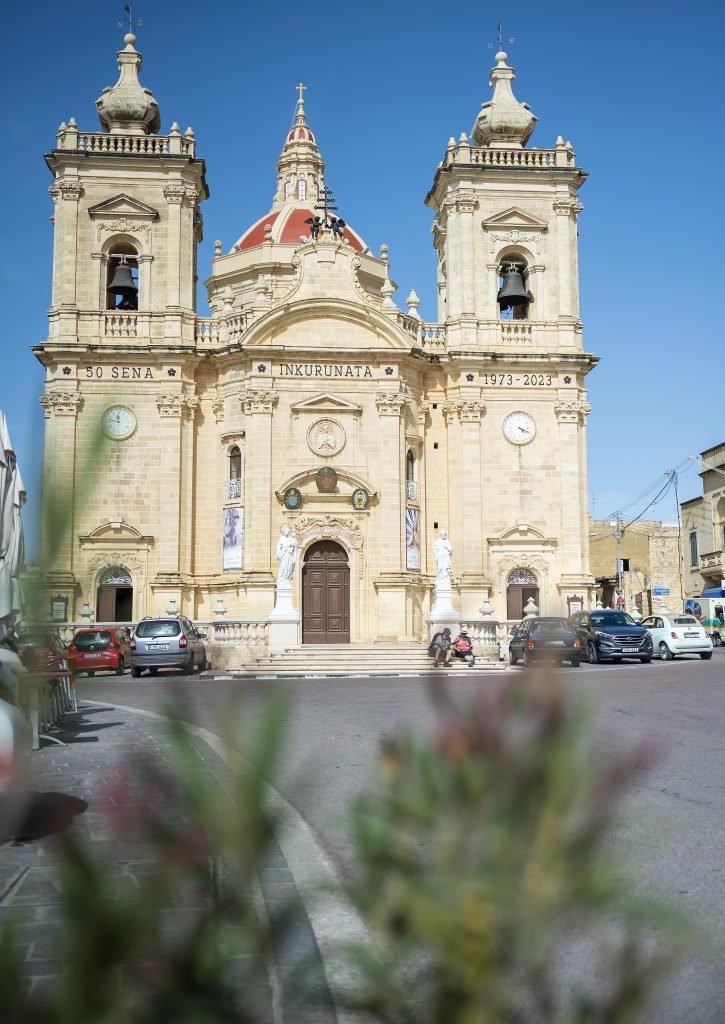The Parish / Church
Legend/interesting fact
In 1798, the onset of French occupation in Gozo unfolded as French soldiers landed on the shores of Ramla Bay, within Xagħra’s confines. Encountering minimal resistance, a contingent received orders to proceed to the Citadel, traversing through Xagħra. Advance warning of the impending invasion had already reached the Gozitans, heightening their preparedness. Knowing what had been happening in other localities, where the French military had ransacked all valuables from religious places, the sexton at Xagħra parish church (the predecessor to the present church, erected in 1692) anticipated a similar fate. Fearing the worst, he strategized to safeguard the church’s valuables, opting to conceal them within one of the church’s numerous tombs. Among the treasures secreted were the main altar lamp and the processional cross, both crafted from silver. Additionally, the valuable bust of the Virgin Mary, adorned in silver attire along with its silver crown, found sanctuary within the tomb.
Yet, restlessness consumed the sexton at night, driven by his inability to bear the notion of the Virgin Mary languishing in the damp, dim recesses. Consequently, under the cover of night, he retrieved the revered artifact from its subterranean refuge and relocated it to a perceived secure corner within the sacristy. Regrettably, the French soldiers, during their village traverse, chose the parish church as their interim abode. Emulating their actions in other locales, they left no valuable unscathed. Consequently, the cherished silver bambina was irrevocably lost.
Though no existing documentation substantiates this narrative, the tangible presence of the wooden bust, along with its silver attire and crown, serve as empirical evidence affirming the recounted event. Further attesting to the occurrence are the silver chandelier (altar lamp) and the silver processional cross, which continue to grace the Basilica to this day, inviting appreciation from all who visit.
Main religious festivities (eg village feast)
The Basilica is transformed into a festive spectacle during Christmas, showcasing diverse Nativity cribs made from various materials. In the first week of January, a captivating re-enactment of the arrival of the three Wise Men takes place in the main square.
At Easter, the Basilica provides a different scene, with 10 papier-mâché Lecce statues displayed beneath the nave arches. Solemn religious ceremonies precede Good Friday, culminating in a well-organised pageant through the village streets. The statues, carried shoulder-high, are accompanied by villagers dressed as biblical figures, accompanied by funeral marches played by the village band. Easter Sunday brings joyous celebrations, featuring the statue of the Risen Christ, accompanied by bell peals and exuberant band processions.
The village feast, coinciding with the National Day of Malta and Gozo on 8th September, commemorates the end of the Great Siege of Malta in 1565. This victory, attributed to the intervention of Our Lady, is also known as Victory Day.
Xagħra comes alive in early September, adorning the church with splendid silver artifacts. The titular statue rests beneath an exquisite canopy, illuminated by Bohemian crystal chandeliers. The church resonates with orchestral melodies during internal celebrations.
Outside, the Basilica’s exterior is brilliantly illuminated, streets adorned with lights and decorations. Band processions and fireworks enhance the festive atmosphere, drawing crowds of enthusiastic attendees.
Specific noteworthy art/religious pieces
The interior of the church is a precious gem itself. Yet, the primary apse above the choir and the expansive barrel-vaulted ceiling immediately draw the eye. Notably, the marble pulpit stands as an evident masterpiece. A highlight not to be missed is the exquisite Maria Bambina statue within the Basilica. Displayed in an ornate niche for most of the year, during festa week, it is placed under a magnificent pavilion, the feast day itself falling on September 8th.
The Patron Saint & the Titular Statue
The Maria Bambina statue, crafted by Galard et fils in Marseilles (1878), is a beloved centrepiece for all the villagers. Elevated onto a silver pedestal in 1913 with a silver sunburst behind, its dress was later adorned with gilded floral designs in the 1930s.
On September 2, 1973, memorable celebrations climaxed in a reverent coronation by Gozo’s Bishop H.L. Nicholas J. Cauchi. The crown, crafted from gold and precious gems, symbolizes the enduring love villagers hold for this revered statue. Villagers generously contributed their own gold items for its creation. Notably, the crown on the statue in the niche is a silver replica of the original gold one.
This treasured crown graces the statue during festa days, a luminous emblem of villagers’ deep devotion.























